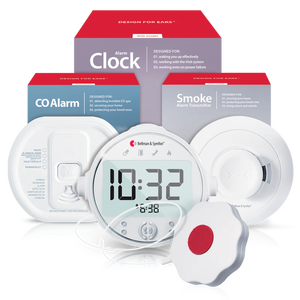Enhance Safety with a Smoke Detector for Deaf Users
Body
Essential Safety: Choosing the Right Smoke Detector for Deaf Users
Ensuring home safety is a fundamental need for every individual, yet traditional fire safety devices often fail to account for the needs of the deaf and hearing impaired. Standard smoke alarms rely on loud auditory warnings, leaving individuals with hearing loss vulnerable in the event of a fire. A smoke detector for deaf users offers lifesaving technology tailored to their unique needs, utilizing visual cues, vibrations, and smart integrations.
In this guide, we’ll explore the features of hearing-impaired smoke alarms, their benefits, and tips for choosing the best one for your home.
Why a Smoke Detector for Deaf Users is Crucial
Bridging the Gap in Fire Safety
Standard smoke detectors emit high-pitched sounds that are ineffective for individuals with partial or total hearing loss. This poses significant risks, as a delayed response to a fire alarm can mean the difference between life and death.
Devices designed for the deaf and hearing impaired use alternative methods to alert users, including flashing strobe lights and vibration signals. These innovations make fire safety inclusive and ensure everyone can promptly respond to emergencies.
How Does a Smoke Detector for Deaf Users Work?
Key Features
Visual Alerts:Bright strobe lights activate when smoke or fire is detected, offering an immediate and noticeable warning.
Vibration Mechanisms:Some devices include bed shakers or portable vibrating receivers that alert users through tactile signals, even during sleep.
Smart Connectivity:Advanced models integrate with smartphones or home automation systems, sending app notifications or triggering additional safety measures.
Combination Alarms:Many smoke detectors for people who are deaf or hard of hearing incorporate multiple alert methods, such as lights, vibrations, and sound, to maximize effectiveness.
Benefits of Smoke Detectors for Deaf Users
Improved Response Time
With visual and tactile alerts, users can react quickly to potential dangers, minimizing the risk of injury or property damage.
Inclusive Safety Solutions
By addressing the specific needs of the deaf and hearing impaired, these devices foster a safer and more inclusive environment for all household members.
Peace of Mind
Knowing you’re equipped with the right safety tools lets you focus on living comfortably and confidently in your home.
Features to Look for in a Smoke Detector for Deaf Users
Powerful Visual Signals
Ensure the device has bright, easily noticeable flashing lights that grab attention even in daylight.
Reliable Vibration Alerts
For bedroom use, opt for smoke detectors with vibration attachments like bed shakers to ensure you’re alerted during sleep.
Smart Technology Integration
Devices that connect to smartphones or home hubs provide added convenience, allowing for remote monitoring and notifications.
Battery Backup
Choose models with long-lasting batteries or backup power systems to ensure functionality during outages.
Compliance with Safety Standards
Verify that the device meets certifications such as UL (Underwriters Laboratories) or NFPA (National Fire Protection Association) requirements for safety and reliability.
Installation Tips for Smoke Detectors for Deaf Users
Follow some tip for installation of a smoke detector for deaf people.
Positioning Matters:Install devices in key areas such as bedrooms, living rooms, and hallways to ensure maximum coverage.
Combine with Other Safety Tools:Pair your smoke detector with additional safety devices like carbon monoxide detectors or smart home systems for a layered approach to safety.
Regular Testing:All features, including lights and vibrations, are tested monthly to ensure they’re functioning correctly.
Professional Installation for Advanced Systems:Professional installation can help optimize performance and integration for smart or interconnected systems.
Maintenance Tips to Keep Your Smoke Detector Functioning
Routine Maintenance Checklist
- Clean Regularly:
Dust or debris can interfere with smoke detection, so wipe the device periodically.
- Replace Batteries:
Follow the manufacturer’s recommendations to keep your smoke detector operational during emergencies.
- Update Firmware:
For smart detectors, ensure your device has the latest updates for improved functionality and security.
Conclusion
A smoke detector for deaf users is not just a piece of equipment—it’s a lifesaving necessity. By combining visual cues, vibrations, and smart technology, these devices provide essential protection tailored to the needs of deaf people.
Investing in one ensures peace of mind and a safer home environment for you and your loved ones. With options ranging from simple visual alarms to fully integrated smart systems, a smoke detector suits every preference and budget. Don’t wait—upgrade your home safety today.












Comments